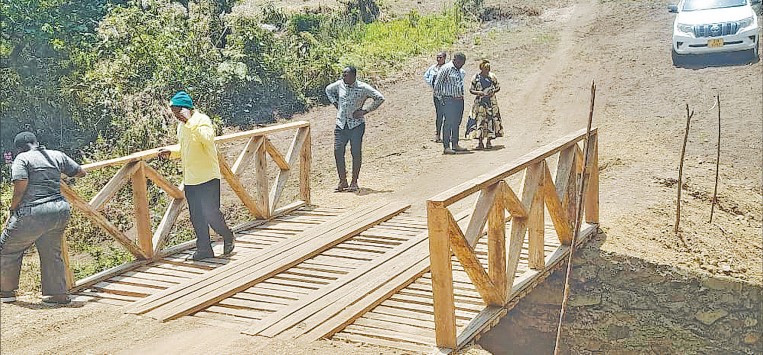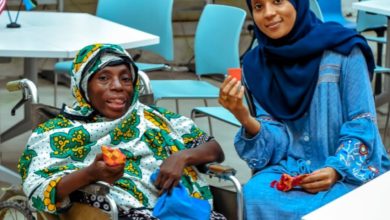When a bridge becomes a beacon of progress

JUST a moment, in many rural parts of Tanzania, simple things like crossing a river or accessing a farm can be monumental challenges that stand in the way of progress and prosperity.
For residents of Isembo Street, Iziwa Ward and surrounding communities in Mbeya, these obstacles were very real until the transformative intervention of TASAF (Tanzania Social Action Fund).
Through the construction of a crucial bridge to them, TASAF has not just built a structure of wood and concrete; they have laid the foundation for economic upliftment, social development and hope.
The bridge, at first glance, might seem like mere infrastructure projects necessary but often overlooked. However, for the communities around Mbeya, TASAF’s bridge is a beacon of change.
It has altered the day-today realities of hundreds of families who rely on farming and livestock for their livelihoods. Before the bridge was built, crossing to the other side was fraught with danger and difficulty. Residents faced treacherous journeys, often risking their safety on unstable paths or long detours.
Transporting crops, livestock and even basic supplies was a daunting task that limited both economic activity and social connection. Roads were muddy or non-existent and access to markets was restricted, forcing many to sell their produce at low prices or miss opportunities altogether.
A mother’s relief and testimony: Veronica’s story
A life testimony of Veronica Mwaseka, a mother of three and a resident of Isembo Street, offers a vivid picture of the transformation. “Our bridge is now in good condition…they have built it for us,” she says with palpable relief.
“We used to be unable to cross, but now we can cross easily with motorbikes and even transportation vehicles, which can now reach the farms. We couldn’t transport our produce before, but now we can easily transport potatoes and maize.” Veronica’s story is a testament to how infrastructure can directly impact food security and family income.
The ease of transporting goods means farmers can reach markets faster, fetch better prices and reduce post-harvest losses. For a mother striving to provide for her children, this bridge is not just concrete, it is hope and sustenance.
Zaina’s journey: From struggle to smooth sailing
Similarly, Zaina Yovela, another local resident, recalls the struggle of the past: “The construction of the bridge has helped us a lot. When we go to the farm or to harvest, we now pass through easily.
Previously, it was difficult to pass on foot or even by motorbike. But now the path is smooth and motorbikes can pass easily and we can also transport our goods without problems.” This improvement might sound simple, but the implications are profound.
Ease of access means more frequent trips to the farm, timely harvesting of crops and the ability to sell fresh produce at peak prices. It also means that emergency services and essential supplies can reach communities more reliably, improving overall well-being.
Abel Mbega: A livestock keeper’s testament
Abel Mbega of Iziwa Ward shares how the bridge has expanded opportunities beyond crop farming: “The construction of the bridge has benefited us greatly because we farm across the other side of the bridge, so now we can transport our produce from that side to this side with ease.
We are also livestock keepers. We go to cut grass on the other side and the bridge has made it much easier to cross.” Abel’s testimony highlights the bridge’s role in supporting diverse livelihoods. Access to pasture and farm inputs is vital for livestock health and productivity.
Previously, the absence of a bridge meant long, exhausting walks that limited productivity and increased risks. “When the bridge was not there, we were forced to walk. But now we can use motorcycles and even cars can pass, so we can cross easily and at any time. Previously, we had to hurry to catch the right time to cross.” His words emphasise the freedom and flexibility that reliable infrastructure brings and that is a freedom that fosters growth and resilience.
Residents of Isengo Street, Iziwa Ward, Mbeya City Council, have found a solution to the long-standing transportation challenges following the completion of a ferry and road project funded by the Social Action Fund (TASAF).
Leading the bridge construction project, Isengo Street Local Government Chairman, Lameck Paulo, said the scheme has greatly benefited residents including children going to school and patients ferried to the nearest health center and especially farmers who previously struggled to transport their produce to the market easily.
“Before this bridge, residents faced great difficulty moving their produce. The path was like a ditch and was hard even to cross on foot. Now, cars, motorcycles, and bicycles pass without obstacles,” Paulo said.
He explained that more than 500 residents of Isengo and neighboring areas have directly benefited from the project.
The chairman mentioned that the benefiting areas include Imbega, Isumbi, Ilumbu, Iduda streets, and the neighboring wards of Nsoho and Ihombe. Paulo added that residents fully participated by providing labor, including carrying stones, sand, and helping in road construction.
He said TASAF provided various materials, including over 25 bags of cement, wood, logs, and nails. Additionally, residents involved in the construction were paid allowances to encourage active participation. A member of Isengo Street Government, Mariam Yahya, said the bridge has been a great help to women, especially in reaching the Meta maternity hospital and nearby health clinics more quickly.
“Previously, it was a big challenge, but now we can reach the hospital on time, which saves the lives of pregnant women and newborns,” Mariam said.
She also stated that the project has helped small traders and middlemen who come to buy produce from farms, thereby expanding the market for agricultural products.
She said Isengo residents mainly engage in farming sweet potatoes, cassava, millet, beans, sugarcane, avocados, pineapples, and various vegetables, most of which are sold in Mbeya markets.TASAF: A catalyst for inclusive development Magdalena Ngenzi, Assistant Coordinator for TASAF in Mbeya City Council, confirms the programme’s impact: “The Mbeya City Council, through Msalaga Ward, Itezi Mlimani Street, is among the areas benefiting from the Productive Social Safety Net (PSSN) implemented by TASAF since 2025.
In this street alone, the programme targets over 27 households.” The programme’s holistic approach combines infrastructure development with direct support, empowering communities to break the cycle of poverty. TASAF’s intervention ensures that vulnerable households receive not just immediate aid but also the tools and environment needed for long-term growth.
“The programme has transformed lives,” Ngenzi asserts, “by providing not only financial assistance but also building critical infrastructure like this bridge, which connects communities and unlocks economic opportunities.”
The ripple effects of the bridge
The bridge’s impact extends beyond the immediate convenience of crossing the river. In a nutshell, it has: Boosted local economies by facilitating market access for farmers and traders; Improved food security through easier transportation and timely harvesting; Enhanced education and health access by enabling children and patients to cross safely; Reduced costs and time for transport, increasing profitability and productivity.
The list also includes fostering social cohesion by connecting previously isolated communities; creating new employment opportunities in construction, transport and agriculture. Here, communities now enjoy safer journeys, increased incomes and a renewed sense of hope and dignity.
TASAF’s bridge project stands as a model for community-driven development where government initiatives directly respond to people’s needs. It highlights how thoughtful investment in infrastructure paired with social safety nets can uplift entire regions. Residents like Veronica, Zaina, Abel and Sara are living proof that change is possible. They urge continued support and expansion of such initiatives to reach more Tanzanians in need.
In the landscape of development, some projects are mere lines on a budget sheet. Others, like TASAF’s bridge in Mbeya, become lifelines that sustain dreams, livelihoods and futures. This bridge is a symbol of what happens when government listens and acts turning hardship into hope, isolation into connection and poverty into progress.
As communities now cross this bridge with ease, so too do they cross into a brighter, more prosperous future. TASAF’s work is a testament to the power of partnership and vision—a reminder that development is not just about buildings but about building better lives. To TASAF, your bridge doesn’t just connect lands; it connects hearts and futures.





